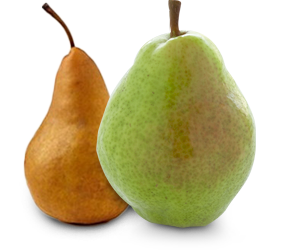STORAGE & HANDLING
ONTARIO PEARS
HOT TIP from the Packer’s Availability and Merchandising Guide -- Retailers who display bartletts as they turn from green to yellow [breaking colour condition] report sales 8 to 10 times greater than when displayed green! Go for the gold!
Russeting is a common characteristic among some of the best-flavoured pears. Scars and other minor skin blemishes do not affect quality. Avoid fruit with skin breaks, punctures or brown skin discolouration. Bartletts will turn yellow and give off an aroma when ripe. Cover pallets of green pears with canvas, which holds in heat and gas to ripen without causing the product to deteriorate.
Optimum Storage Conditions:
a. Remove field heat immediately
b. Use a dedicated storage with constant temperature and humidity levels
c. Pears will freeze at -2º C therefore, a range of 0 to -1 º C is recommended.
d. Relative humidity of 90 to 95%
Maximum storage period:
a. Bartlett – 2.5 to 3 months
b. Bosc – 3.5 to 4 months
An additional 1 to 2 months can be added by utilizing proper CA storage.
Scald can be a factor in long term storage and can be managed similar to apples.
Handling of pears through grading and packing can result in fruit scaring. It is recommended that pears be graded and packed quickly after harvest and stored in a packed format. Pears held in bulk bins for longer periods should be graded by hand.
Properly managed, the marketing of pears can be successfully spread over the time periods suggested. Poorly stored pears will not last as long and can result in the loss of product and distressed pricing.
CARE & STORAGE FOR ONTARIO TENDER FRUIT:
Ontario tender fruit is exactly that tender. Peaches, plums and pears demand proper care and storage in order to maintain their quality. Fresh bright colours of properly ripened fruit are a natural draw for the consumerís eye. To ensure your merchandising displays are attracting the attention they deserve follow these simple guidelines:
1. Do not store tender fruit above 35 F (2 C); quickens ripening and can cause internal breakdown.
2. Avoid stacking baskets of fruit or rough handling.
3. Frequently cull displays for damaged fruit to prevent the spread of spoilage.
4. Ontario tender fruit is delicate, remember "the least amount of handling is best."
5. Pears produce and absorb odours [i.e. do not display or store near onions].
FOOD SAFETY
The Ontario tender fruit and grape industry has built its reputation by consistently supplying Canadian retailers with safe quality fruit.
The Ontario Tender Fruit Producers' and the Ontario Fresh Grape Growers' Marketing Boards, in conjunction with the Canadian Horticultural Council have adopted the Canada GAP OFFS (On Farm Food Safety) program based on the seven basic principles of the internationally-recognized HACCP (Hazard Analysis and Critical Control Point) approach.
For more information on the program please visit the CanadaGap website: www.canadagap.ca.






